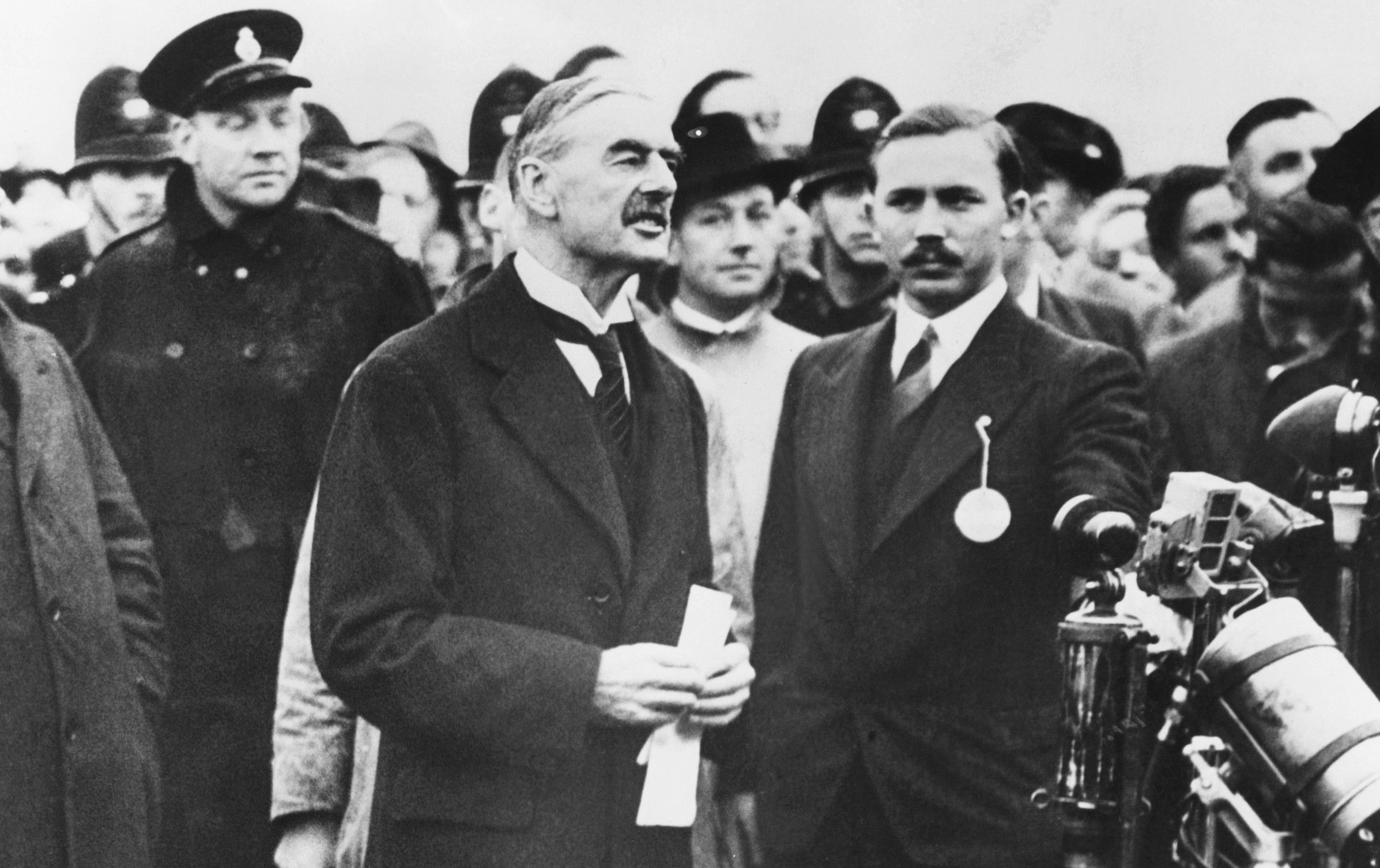Contemporary neoconservatism is, in its guiding precepts and policy manifestations, a profoundly ahistorical ideology. It is a millenarian project that not just eschews but explicitly rejects much of the inheritance of pre-1991 American statecraft and many generations of accumulated civilizational wisdom from Thucydides to Kissinger in its bid to remake the world.
It stands as one of the enduring ironies of the post-Cold War era that this revolutionary and decidedly presentist creed has to shore up its legitimacy by continually resorting to that venerable fixture of World War II historicism, the 1938 Munich analogy. The premise is simple, and, for that reason, widely resonant: British Prime Minister Neville Chamberlain, in his “lust for peace,” made war inevitable by enabling Adolf Hitler’s irredentist ambitions until they could no longer be contained by any means short of direct confrontation between the great powers.
Professor Andrew Bacevich brilliantly distilled the Munich analogy’s two constituent parts: “The first truth is that evil is real. The second is that for evil to prevail requires only one thing: for those confronted by it to flinch from duty,” he wrote. “In the 1930s, with the callow governments of Great Britain and France bent on appeasing Hitler and with an isolationist America studiously refusing to exert itself, evil had its way.” This is the school playground theory of international relations: failure to stand up to a bully at the earliest possible opportunity only serves to embolden their malignant behavior, setting the stage for a larger and more painful fight down the line.
The Cold War years saw a feverish universalization of the Munich analogy whereby every foreign adversary is Adolf Hitler, every peace deal is Munich 1938, and every territorial dispute is the Sudetenland being torn away from Czechoslovakia as the free world looks on with shoulders shrugged. This was the anxiety animating the spurious domino theory that precipitated U.S. involvement in Korea and Vietnam, but appeasement fever was kept in check by the realities of a bipolar Cold War competition that imposed significant constraints on what the U.S. could do to counteract its powerful, nuclear-armed Soviet rival.
These constraints were lifted virtually overnight with the fall of the Berlin Wall and dissolution of the Soviet bloc. President George H.W. Bush proclaimed the end of the “Vietnam syndrome,” or Americans’ healthy skepticism of war stemming from the disastrous decades-long intervention in Vietnam, following U.S. forces’ crushing victory in the Gulf War. The George W. Bush administration gave itself infinite license to intervene anywhere against anyone, including preemptively against “imminent threats,” on the grounds that anything less is tantamount to appeasement. “In the 20th century, some chose to appease murderous dictators, whose threats were allowed to grow into genocide and global war,” Bush said in 2003. “In this century, when evil men plot chemical, biological and nuclear terror, a policy of appeasement could bring destruction of a kind never before seen on this earth.”
Even as the threat landscape has shifted since 2003, neoconservatism’s epigoni have trotted out the Munich analogy to justify every subsequent military intervention in the Middle East. Where direct confrontation is too costly and risky, as with Russia and China, the historicists insist that anything short of a policy of total, unrelenting maximum pressure and isolation amounts to appeasement.
Thus we are subjected to the insistence, one which was always implausible but comes off as especially fantastical today, that any conclusion to the Ukraine war short of Russia’s total battlefield defeat is redolent of Chamberlain at Munich.
The Munich analogy is potent insofar as it has been used as a neoconservative cudgel to bash all dissenters as craven fools who would sell out their principles for an illusory promise of peace, but that doesn’t make it true. The reality of Munich, if it’s of any help to anyone, is that Hitler was both unappeasable and undeterrable in the context of mid-20th century European international politics. Nazi Germany was a uniquely dangerous adversary because it was a revisionist power with virtually unlimited, and therefore insatiable, territorial and political objectives. France and Britain could not give Hitler what he sought – to wit, destroying the international system and rebuilding it from the ground up with Germany as the global hegemon – even if they wanted to. Threats and shows of force would have shifted Hitler’s tactical calculations, but they would not have dissuaded him from the conclusion that his objectives could only be achieved through a general European war that he believed Germany could win. Paris and London were caught militarily and geopolitically flat-footed against a resurgent Germany as the U.S. continued to adhere to a policy of neutrality, a united anti-fascist front with Soviets was politically not in the cards, and ultranationalist governments were coming to power across the continent in a way that further tipped the scales against Europe’s remaining liberal powers.
Critics of “appeasement” distort the difficult policy landscape that confronted Britain and France, conjuring up opportunities for deterrence and preemption that simply did not exist in mid 1938. They distill these specious arguments into a historical analogy, the “lesson of Munich,” that doesn’t even work in its own original setting and impose it as a kind of sacred truth through which all U.S. policy decisions must be filtered.
The U.S. has never again faced an adversary like Nazi Germany. The USSR, for all its revolutionary aesthetics and rhetoric, was a status quo power that competed but also cooperated with the U.S. on the margins and never sought to challenge core Western security interests in the way that Nazi Germany did.
The contemporary strategic landscape is even less reminiscent of the 1930’s. China harbors regional ambitions in the Asia-Pacific that are situationally at odds with U.S. interests, and Russia seeks to prevent post-Soviet states from drifting into the Western camp in ways that pose a challenge to NATO. But neither adversary is pursuing objectives that can only be achieved through great power conflict, positioning itself as a global hegemon, or trying to overthrow the international system. As I explained along with my colleagues George Beebe and Anatol Lieven, Russia invaded Ukraine as part of a strategy of hybrid compellence to curtail the West’s influence in part of the post-Soviet sphere, not as a prelude to a larger planned program of continental conquest against NATO states.
The Munich analogy is deeply dangerous not because it is historically illiterate and utterly inapplicable to the challenges America faces today – though it certainly is both those things – but because, in its framing of adversaries as existential enemies that must be pressured, isolated, and confronted at every step, it precipitates the very catastrophe it is supposedly warning against. Managing these complex strategic relationships in a way that does not lead to war between the great powers will require a diverse, flexible policy toolkit that recognizes our limited resources and is able to balance deterrence and engagement, rather than committing to a policy of rollback that would have been appropriate against Nazi Germany but simply does not capture the contemporary threat environment.
The real “lesson of Munich” is how corrosive ideologically-driven historicism, completely untethered from actual history, can be to the foreign policy debate. It is long past time to lay the ghosts of 1938 to rest.
















